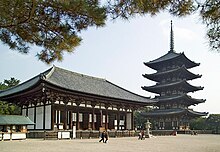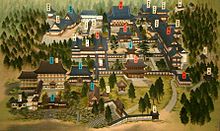Japanese Buddhist schools[edit]
Japanese Buddhism is very diverse with numerous independent schools and temple lineages (including the "old" Nara schools and the "new" Kamakura schools) that can be traced back to ancient and medieval Japan, as well as more recent Japanese New Religious movements and modern lay organizations.
According to the religious statistics of 2021 by the Agency for Cultural Affairs of Japan, the religious corporation under the jurisdiction of the Ministry of Education, Culture, Sports, Science and Technology in Japan had 135 million believers, of which 47 million were Buddhists and most of them were believers of new schools of Buddhism which were established in the Kamakura period (1185-1333).
The number of believers of each sect is approximately
- 22 million for the Jōdo Buddhism (Jōdo-shū, Jōdo Shinshū, Yuzu Nembutsu and Ji-shū),
- 11 million for the Nichiren Buddhism,
- 5.5 million for the Shingon Buddhism,
- 5.3 million for the Zen Buddhism (Rinzai, Sōtō and Ōbaku),
- 2.8 million for the Tendai Buddhism, and
- only about 700,000 for the old schools, which were established in the Nara period (710-794).[7]
An old saying regarding the schools of Buddhism in relation to the different classes is:
Some of the major groups are outlined below.
The Old Schools[edit]
Six Nara Schools[edit]
The Six Nara Schools are the oldest Buddhist schools in Japan. They are associated with the ancient capital of Nara, where they founded the famed "seven great temples of the southern capital" (Nanto Shichi Daiji 南都七大寺).
The six schools are:[141]
- Hossō - East Asian Yogācāra (法相宗, Hossō) is based on the Idealistic "consciousness-only" philosophy of Asanga and Vasubandhu. The East Asian Yogācāra school of Buddhism was founded by Xuanzang (玄奘, Jp. Genjō) in China c. 630 and introduced to Japan in 654 by Dōshō, who had travelled to China to study under him.[142] The Discourse on the Theory of Consciousness-Only (成唯識論, Jōyuishiki-ron) is an important text for the Hossō school. Hossō was connected with several prominent temples: Hōryūji, Yakushiji, and Kōfukuji.
- Kusha - This is a school of Nikaya Buddhism which focused on the Abhidharmakośabhaṣya" (倶舎論), a compendium of Abhidharma by the fourth-century Buddhist philosopher Vasubandhu. Kusha was never a truly independent school, instead it was studied along with Hossō doctrine.
- Sanron - The Chinese Three-Discourse School was transmitted to Japan in the 7th century. It is a Madhyamaka school which developed in China based on two discourses by Nagarjuna and one by Aryadeva. Madhyamaka is one of the most important Mahayana philosophical schools, and emphasizes the emptiness of all phenomena. Sanron was the focus of study at Gangōji and Daianji.
- Jōjitsu - A tradition focused on the study of the Tattvasiddhi shastra, a text possibly belonging to the Sautrantika school. It was introduced in 625 by the monk Ekwan of Goryeo.[143] Jōjitsu was never an independent school, instead it was taught in tandem with Sanron.
- Kegon - The Kegon (Ch. Huayan, Skt. Avatamsaka) school was founded by Dushun (杜順, Dojun) c. 600 and was introduced to Japan by the Indian monk Bodhisena in 736. The Avatamsaka Sutra (Kegon-kyō 華厳経) is the central text (along with the writings of the Chinese Huayan patriarchs).
- Risshū - The Risshū (Ritsu or vinaya school) was founded by Daoxuan (道宣, Jp. Dosen), and introduced to Japan by Jianzhen in 753. The Ritsu school specialized in the Vinaya (the Buddhist monastic rules). They used the Dharmagupta version of the vinaya which is known in Japanese as Shibunritsu (四分律). It was closely associated with Tōshōdaiji.
Esoteric Schools[edit]
- Tendai - This is a branch of the Chinese Tiantai school introduced by Saichō, who also introduced tantric elements into the tradition. The primary text of Tiantai is Lotus Sutra, but the Mahavairocana Tantra (大日経, Dainichikyō) is also important.
- Shingon Buddhism (真言宗, Shingon-shū) was founded by Kūkai in 816, who traveled to China and studied the Chinese Mantrayana tradition. In China, Kūkai studied Sanskrit, and received tantric initiation from Huiguo. Shingon is based mainly on two tantric scriptures, the Mahavairocana Tantra and the Vajrasekhara Sutra (金剛頂経, Kongōchōkyō).
- Shugendō, an eclectic tradition which brought together Buddhist and ancient Shinto elements. It was founded by En no Gyōja (役行者, "En the ascetic").
The New Schools[edit]
During the Kamakura period, many Buddhist schools (classified by scholars as "New Buddhism" or Shin Bukkyo), as opposed to "Old Buddhism" (Kyū Bukkyō) of the Nara period.
The main New Buddhism schools are:
- The Jōdo-shū (Pure Land school) founded by Hōnen (1133–1212), focused on chanting the name of Amida Buddha so as to be reborn in the Pure land.
- The Yūzū-Nembutsu school was founded by Ryōnin (良忍, 1072–1132), this is another Pure Land school.
- The Jōdo Shinshū (True Pure Land) founded by Shinran (1173–1263)
- The Rinzai school of Zen founded by Eisai (1141–1215), a Japanese branch of the Chinese Linji school, focuses on zazen sitting meditation, and kōan practice.
- The Sōtō school of Zen founded by Dōgen (1200–1253), a Japanese branch of the Chinese Caodong school, also focuses on zazen.
- The Nichiren school founded by Nichiren (1222–1282) which focuses on the Lotus Sutra and reciting the name of the Lotus Sutra.
- The Ji-shū branch of Pure Land Buddhism founded by Ippen (1239–1289)
- The Fuke-shū sect of Zen was founded by Puhua in 1254.
- Shingon-risshū ("The Shingon-Vinaya school"), founded by Eison (1201-1290)
Other schools of Japanese Buddhism[edit]
After the Kamakura period, there were other Buddhist schools founded throughout the history of Japan, though none have attained the influence of the earlier traditions on the island. Some of these later schools include:
- The Ōbaku School of Zen was introduced by Ingen in 1654.
- Sanbo Kyodan ("Three Treasures Religious Organization"), a relatively new sect of Zen founded by Hakuun Yasutani in 1954
Japanese New Religious Movements[edit]
There are various Japanese New Religious movements which can be considered Buddhist sects, the largest of these are lay Nichiren Buddhist groups such as Soka Gakkai, Reiyūkai and Risshō Kōsei-kai. But there are other new movements such as Agon Shū (阿含宗, "Agama School"), a Buddhist school which focuses on studying the Agamas, a collection of early Buddhist scriptures.







